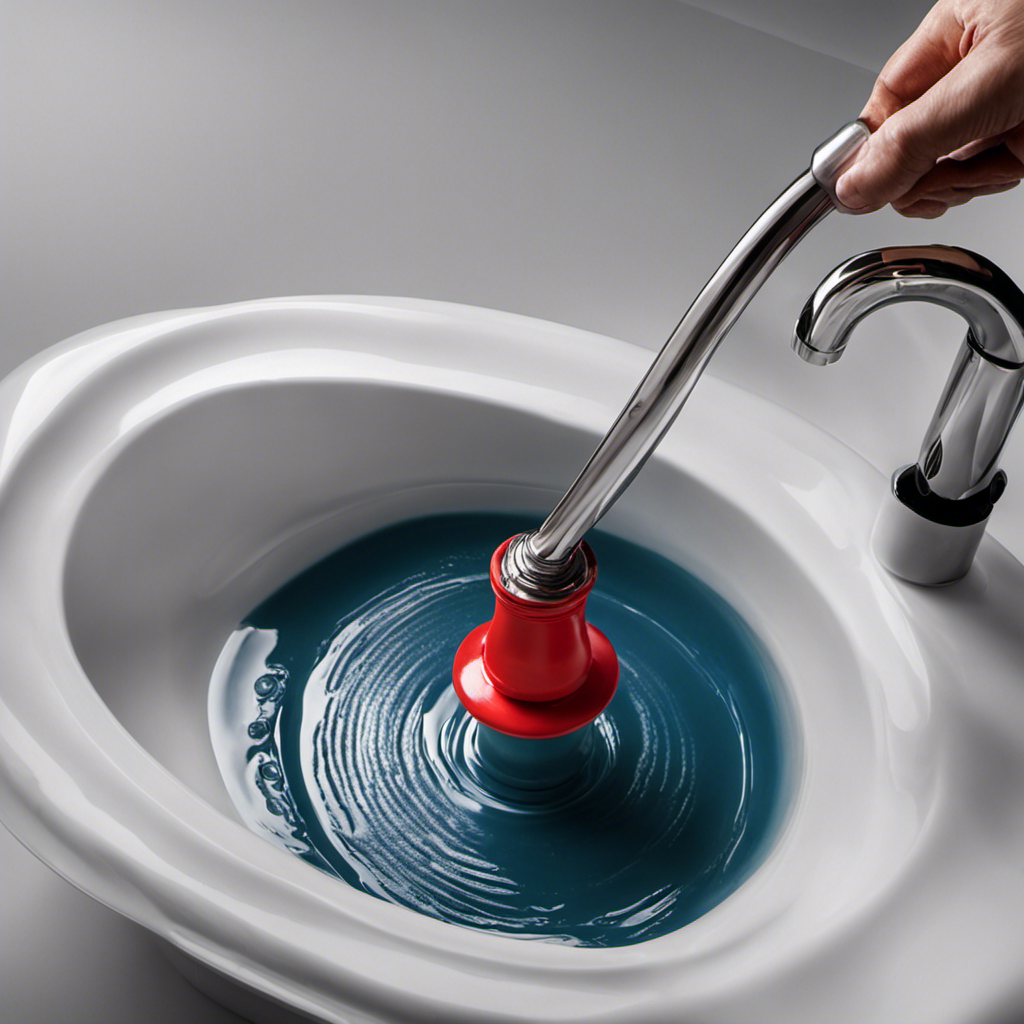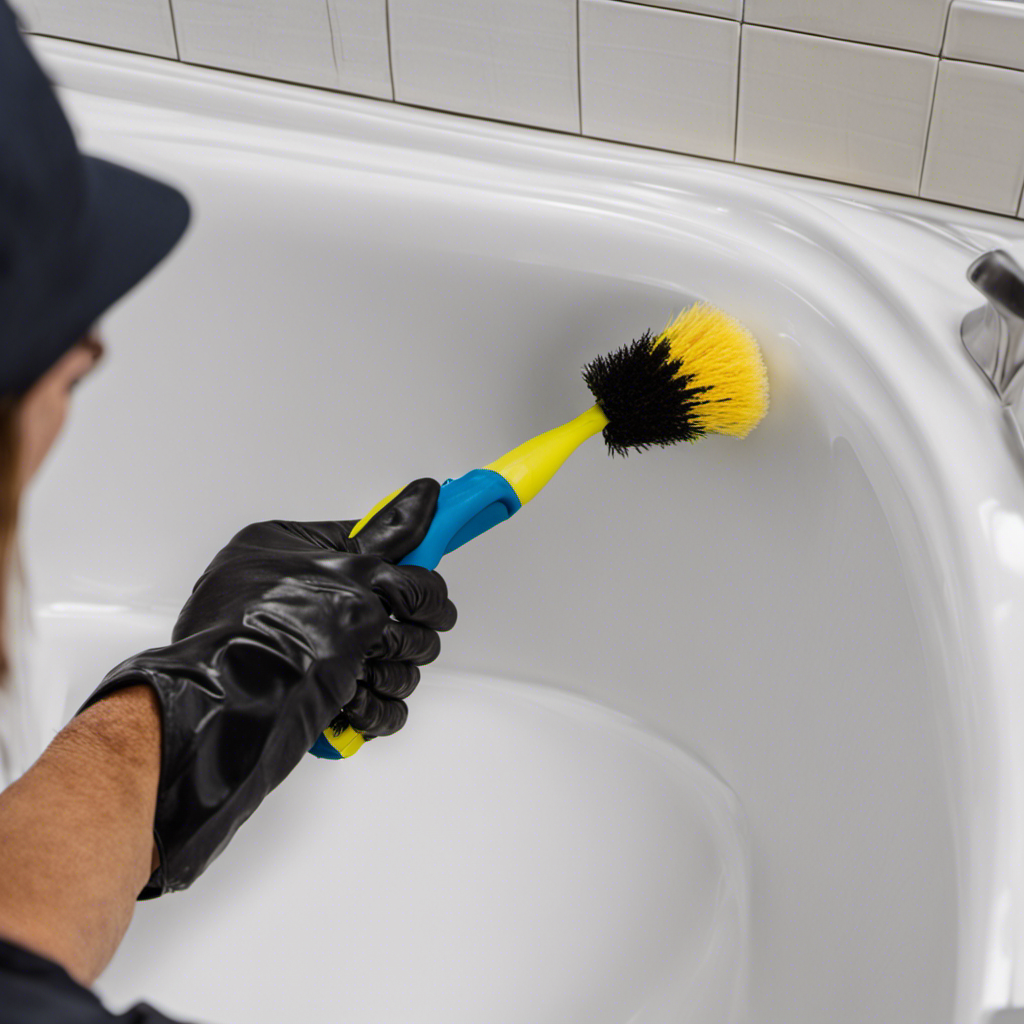Are you tired of struggling with outdated, worn-out bathtub faucet handles? It’s time to take control and replace them yourself.
In this article, we’ll guide you through the step-by-step process of assessing, gathering, removing, inspecting, installing, and testing new bathtub faucet handles.
With our expert advice and your determination, you’ll have a functional and stylish upgrade in no time. Say goodbye to leaky, difficult-to-use handles and hello to a refreshing bathing experience.
Let’s get started!
Key Takeaways
- Assess the condition and performance of bathtub faucet handles
- Gather the necessary tools and materials for replacement
- Prepare for the replacement by turning off the water supply and removing the old handles
- Choose and install new handles that match the bathroom style and ensure compatibility with the existing faucet
Assessing the Condition of Your Bathtub Faucet Handles
Before you start replacing your bathtub faucet handles, it’s important to assess their current condition. Evaluating handle performance is crucial to determine if replacement is necessary.
Start by checking if the handles turn smoothly without any resistance or squeaking noises. If they are difficult to turn or make unusual sounds, it could indicate internal damage or wear.
Additionally, inspect the handles for any signs of corrosion, rust, or discoloration, as these could affect their functionality and appearance.
Troubleshooting common faucet handle issues such as leaks or loose handles is also important. Look for any water dripping or pooling around the handles and ensure that they are securely attached to the faucet.
Gathering the Necessary Tools and Materials
To successfully replace your bathtub faucet handles, you will need a few essential tools and materials.
Firstly, you will require an adjustable wrench or a basin wrench to loosen and remove the existing handles.
Additionally, you will need replacement handles that are compatible with your faucet model, as well as plumber’s tape to ensure a secure and leak-free installation.
Properly gathering these tools and materials beforehand will ensure a smooth and efficient replacement process.
Required Tools and Materials
You’ll need a few tools and materials to replace bathtub faucet handles. Here are three essential items you’ll need for a successful installation:
-
Adjustable wrench: This tool is crucial for loosening and tightening the nuts that secure the faucet handles.
-
Screwdriver: Depending on the type of screws used, you may need a Phillips or flathead screwdriver to remove the screws holding the old handles in place.
-
New faucet handles: When choosing the right handle design, consider the style and functionality that best suits your bathroom. Whether you prefer traditional knobs or modern levers, make sure to select handles that match the existing plumbing fixtures and your personal taste.
With these tools and materials in hand, you’ll be ready to tackle the task of replacing your bathtub faucet handles with confidence.
Preparation for Replacement
With the right tools and materials, you can easily prepare for the replacement of your bathtub faucet handles. Before starting the replacement process, it is important to gather all the necessary items and make some preparations. Here are some helpful tips to ensure a smooth and successful replacement:
-
Turn off the water supply: Before you begin, make sure to turn off the water supply to your bathtub to prevent any leaks or accidents.
-
Gather the tools and materials: You will need a wrench, pliers, screwdriver, and the replacement faucet handles. Check the table below for a list of recommended handles.
-
Remove the old handles: Use the appropriate tools to carefully remove the old faucet handles from your bathtub.
-
Clean the area: Once the old handles are removed, clean the area around the faucet to remove any debris or buildup.
By following these preparation tips and selecting the right replacement handles, you will be well on your way to successfully replacing your bathtub faucet handles. Happy DIY-ing!
| Handle Type | Material | Style |
|---|---|---|
| Knob | Brass | Classic |
| Lever | Chrome | Modern |
| Cross | Stainless Steel | Vintage |
| Push-Pull | Plastic | Contemporary |
Turning off the Water Supply to the Bathtub
First, make sure the water supply to the bathtub is turned off before attempting to replace the faucet handles. This is an important step to prevent any water leakage or accidents during the replacement process.
Here are a few things to keep in mind when shutting off the water:
-
Locate the shut-off valves: Look for the shut-off valves near the bathtub. These valves are usually located under the sink or behind an access panel.
-
Turn off the valves: Use a wrench to turn the valves clockwise until they are fully closed. This will stop the water flow to the bathtub.
-
Test the water supply: Turn on the faucet to check if the water supply has been successfully shut off. If no water flows, then you have successfully turned off the valves.
Removing the Old Bathtub Faucet Handles
Now that you have successfully turned off the water supply to your bathtub, it’s time to move on to the next step: removing the old bathtub faucet handles.
Evaluating handle grip comfort is important when choosing new handles, but before you can do that, you need to remove the old ones.
To start, locate the set screw on the underside of each handle. This screw is typically hidden beneath a decorative cap or cover. Use a screwdriver or Allen wrench to loosen and remove the set screw.
If you encounter any resistance or trouble removing the handles, don’t worry. It’s common to face issues such as stuck handles or stripped set screws. In such cases, try using penetrating oil to loosen the handle or a screw extractor to remove a stripped set screw. If all else fails, consult a professional plumber for assistance.
Inspecting the Valve Stems and Cartridges
Next, take a moment to inspect the valve stems and cartridges to assess their condition and determine if they need replacement. This step is crucial for a successful faucet handle replacement. Here are three important points to keep in mind while evaluating the valve stems and cartridges:
-
Evaluating handle compatibility: Check if the valve stems and cartridges are compatible with the new faucet handles you plan to install. Different models and brands may have different sizes and designs, so it’s important to ensure a proper fit.
-
Troubleshooting common problems: Look for signs of wear and tear, such as leaking or difficulty in turning the handles. If the valve stems or cartridges are damaged or malfunctioning, they will need replacement to ensure smooth operation of the new handles.
-
Inspecting for debris: Remove any dirt, debris, or mineral buildup that may be affecting the function of the valve stems and cartridges. Cleaning them thoroughly will help prevent future issues and ensure optimal performance.
Choosing the Right Replacement Handles for Your Bathtub Faucet
When choosing replacement handles for your bathtub faucet, it’s essential to consider factors such as style, material, and compatibility.
There are various replacement handle options available to suit your preferences and needs. From traditional knobs to contemporary lever handles, you can find a style that complements your bathroom decor.
When it comes to materials, you can choose from options like brass, chrome, or stainless steel, depending on your desired durability and aesthetic.
Additionally, it is crucial to ensure that the replacement handles are compatible with your bathtub faucet model. Before purchasing, take note of the brand, model, and measurements of your existing handles to ensure a proper fit.
Installation tips include following the manufacturer’s instructions carefully and using the appropriate tools to ensure a secure and leak-free connection.
Installing the New Bathtub Faucet Handles
To install the new handles, make sure to turn off the water supply and use a screwdriver to remove the old ones.
Installing the new handle design for your bathtub faucet can be a simple and rewarding task. Here are a few tips to help you along the way:
- Choose handles that match the style and finish of your bathroom.
- Ensure that the new handles are compatible with your existing faucet.
- Follow the manufacturer’s instructions for proper installation.
When installing the new handles, it’s important to troubleshoot any errors that may arise. Common issues include handles that don’t fit properly or don’t turn smoothly. If you encounter these problems, double-check that you have the correct handle size and consider adjusting the handle’s position.
With the new handles securely in place, you can move on to testing their functionality and ensuring that they operate smoothly and efficiently.
Testing the Functionality of the New Handles
When testing the functionality of your new bathtub faucet handles, it is important to ensure proper water flow. This means checking that the water is flowing smoothly and at the desired pressure.
Additionally, evaluating the handle durability is crucial to determine if they can withstand repeated use without breaking or becoming loose.
Ensuring Proper Water Flow
Make sure you’re using the correct size wrench to remove the old faucet handles. This will ensure a smooth removal process and prevent any damage to the handles or the bathtub.
Once you have successfully removed the old handles, it’s time to install the new ones. Proper handle installation is crucial to ensure proper water flow and prevent any leaks or drips. Here are some important steps to follow:
- Check the manufacturer’s instructions for the correct installation method.
- Ensure that the handles are aligned properly with the water supply valves.
- Tighten the handle screws securely to prevent any wobbling or movement.
If you notice any issues with water flow after installing the new handles, troubleshooting the problem is necessary. Check for any debris or mineral buildup in the faucet aerator or cartridge. Clean or replace these components as needed. If the problem persists, it’s recommended to consult a professional plumber for further assistance.
Evaluating Handle Durability
If you want to ensure the durability of your handles, it’s important to choose a material that is resistant to corrosion and wear. Evaluating handle design and comparing handle styles can help you make an informed decision. Here is a table that compares different handle materials based on their durability:
| Material | Corrosion Resistance | Wear Resistance |
|---|---|---|
| Stainless Steel | High | High |
| Brass | Medium | Medium |
| Plastic | Low | Low |
Stainless steel handles offer the highest level of corrosion and wear resistance, making them a popular choice for long-lasting durability. Brass handles offer moderate resistance to corrosion and wear, while plastic handles have lower durability. When evaluating handle design, consider factors such as ergonomic shape, ease of grip, and overall sturdiness. By carefully considering these aspects and choosing a durable material, you can ensure that your handles will withstand the test of time.
Adjusting the Temperature Control on Your New Handles
To adjust the temperature control on your new handles, simply turn the handle to the left for hotter water and to the right for colder water. It’s a simple and intuitive process that allows you to customize your bathing experience.
Here are some key points to keep in mind when adjusting the temperature control on your new handles:
-
Consistency: Ensure that the handle is firmly in place to maintain a consistent water temperature throughout your shower or bath.
-
Adjusting water pressure: If you want to increase or decrease the water pressure, there is usually a separate lever or knob that can be adjusted to suit your preferences.
-
Troubleshooting common issues: If you experience any issues with the temperature control, such as inconsistent temperatures or difficulty turning the handle, it may be necessary to check the internal components for any damage or debris that could be affecting its functionality.
Properly Maintaining and Caring for Your New Bathtub Faucet Handles
When it comes to properly maintaining and caring for your new bathtub faucet handles, there are a few key points to keep in mind.
First, understanding the right cleaning and polishing techniques is essential to keeping them looking their best.
Additionally, taking steps to prevent wear and tear, such as avoiding abrasive cleaners, can help prolong their lifespan.
Lastly, choosing durable materials for your handles, like stainless steel or brass, can ensure they stand up to everyday use and maintain their functionality for years to come.
Cleaning and Polishing Techniques
You can easily clean and polish your bathtub faucet handles using a mixture of vinegar and baking soda. Here are some effective cleaning techniques and polishing materials to keep your faucet handles looking shiny and new:
-
Vinegar and Baking Soda: Create a paste by mixing equal parts vinegar and baking soda. Apply the paste to the faucet handles and let it sit for a few minutes. Use a soft cloth or sponge to scrub away dirt and grime. Rinse with water and dry with a clean cloth.
-
Lemon Juice: Cut a lemon in half and rub the cut side over the faucet handles. The acidic properties of lemon juice will help remove stains and restore shine.
-
Toothpaste: Apply a small amount of toothpaste to a soft cloth and gently rub it onto the faucet handles. The mild abrasive in toothpaste can help remove stubborn stains and tarnish.
Preventing Wear and Tear
Regular cleaning and polishing can help prevent wear and tear on your bathtub faucet handles. By taking simple steps to maintain your handles, you can prevent corrosion and extend their lifespan.
Start by regularly wiping down the handles with a soft cloth and mild soap. This will remove any dirt or grime that may accumulate over time. Be sure to dry the handles thoroughly to prevent water spots and mineral buildup.
Additionally, consider applying a protective coating or wax to the handles to create a barrier against moisture and fingerprints. This will not only keep your handles looking shiny and new, but it will also prevent corrosion from setting in.
Choosing Durable Materials
To ensure durability, it’s important to choose materials that can withstand daily use and resist corrosion. When it comes to replacing bathtub faucet handles, there are several durable material options available. Here are three options to consider:
-
Brass: Brass handles are known for their durability and resistance to corrosion. They are also easy to clean and maintain. However, brass handles can be more expensive compared to other materials.
-
Stainless Steel: Stainless steel handles are another great choice for durability. They are resistant to rust and corrosion, making them ideal for bathroom environments. Additionally, stainless steel handles are sleek and modern in appearance.
-
Zinc Alloy: Zinc alloy handles are a cost-effective option that offers decent durability. While not as durable as brass or stainless steel, they are still a good choice for those on a budget. However, they may require more maintenance to prevent corrosion.
When choosing a material for your bathtub faucet handles, consider the pros and cons of each option to ensure you make the right choice for your needs.
Frequently Asked Questions
How Do I Know if My Bathtub Faucet Handles Need to Be Replaced?
If you notice signs of wear like rust, cracks, or difficulty turning, it’s time to replace your bathtub faucet handles. If you’re unsure, it’s best to call a plumber for a professional assessment.
Can I Use Any Replacement Handles for My Bathtub Faucet, or Do I Need to Choose Specific Ones?
To choose the right replacement handles for your bathtub faucet, you need to consider compatibility. Not all handles will fit all faucets, so it’s important to choose specific ones that are designed for your model.
Are There Any Special Tools Required to Remove the Old Bathtub Faucet Handles?
To remove the old bathtub faucet handles, you’ll need a few special tools. These include a screwdriver, pliers, and possibly an Allen wrench. These tools will help you easily and safely replace the handles.
How Can I Adjust the Temperature Control on My New Handles?
To adjust the temperature control on your new handles, locate the set screw on the handle and use an Allen wrench to loosen it. Then, you can easily troubleshoot any handle issues that may arise.
What Are Some Tips for Maintaining and Caring for My New Bathtub Faucet Handles?
To maintain and care for your new bathtub faucet handles, it’s important to clean them regularly using a mild soap and water solution. Avoid using abrasive cleaners to prevent scratching. Additionally, check for any loose screws and tighten them as needed.
Conclusion
In conclusion, replacing your bathtub faucet handles is a straightforward process that can be accomplished with the right tools and materials. By following the steps outlined in this guide, you can ensure a successful installation and enjoy the functionality of your new handles.
Remember to properly maintain and care for your new handles to prolong their lifespan. As the saying goes, "A stitch in time saves nine," so don’t delay in replacing those worn-out handles and restore the elegance and convenience to your bathroom.










